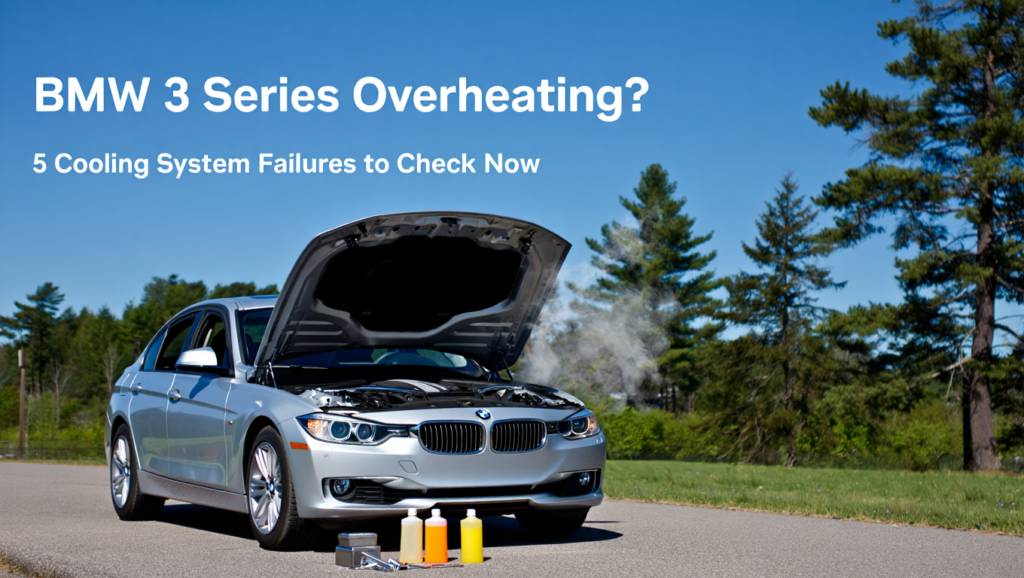
Is your BMW 3 Series running hotter than it should? You’re not alone. Overheating issues are one of the most common problems BMW owners face, especially in older 3 Series models.
Your car’s cooling system is basically its lifeline. When it starts to fail, it doesn’t just mean an annoying warning light – it could lead to serious engine damage that costs thousands to fix.
About 40% of BMW 3 Series vehicles over five years old will experience some type of cooling system issue. The good news? Most problems give you warning signs before they become major disasters.
Watch out for:
- Temperature warning lights on your dashboard
- Steam coming from under your bonnet
- A sweet, syrupy smell (that’s leaking coolant)
- Temperature gauge reading higher than normal
- Reduced engine performance
Let’s look at the five most common cooling failures that could be affecting your BMW right now.
Understanding Your BMW’s Cooling System
How the BMW 3 Series Cooling System Works
Your BMW’s cooling system is a bit like your home’s central heating – it’s a closed circuit that keeps temperatures just right. Coolant (a mix of antifreeze and water) constantly circulates through your engine, absorbing heat before passing through the radiator to cool down.
The main parts include:
- Radiator – the large heat exchanger at the front of your car
- Water pump – circulates the coolant through the system
- Thermostat – regulates when coolant flows to the radiator
- Expansion tank – stores extra coolant and manages pressure
- Hoses and connections – the “pipes” of your cooling system
BMW cooling systems need more attention than some other cars because they often use plastic components that can become brittle with age and heat cycles.
Warning Signs of BMW Cooling System Failure
Your car will usually tell you when something’s wrong – if you know what to look for:
- Temperature gauge climbing into the red zone
- Engine temperature warning light coming on
- Steam billowing from under your bonnet
- Sweet smell inside or outside the car (this is leaking coolant)
- Puddles of greenish or pinkish fluid under your car
- Car running rough or using more fuel than usual
Don’t ignore these signs – they rarely fix themselves!
5 Common BMW 3 Series Cooling System Failures
1. Water Pump Failure
The water pump is often the first cooling component to fail in a BMW 3 Series. Most BMW pumps use plastic impellers (the spinning part that moves the coolant) which can crack or break over time.
In many 3 Series models, you can expect the water pump to last about 60,000 to 80,000 miles. After that, you’re living on borrowed time.
Signs your water pump is failing:
- Engine overheating at idle or in traffic
- Coolant leaks from the front-centre of the engine
- Whining noises from the front of the engine
- Fluctuating temperature gauge readings
A replacement pump in the UK typically costs £300-£500 including parts and labour. That’s much cheaper than a new engine, which is what you might need if you ignore a failed water pump!
2. Thermostat Malfunctions
Your BMW’s thermostat is like a gate-keeper, controlling coolant flow to maintain the perfect engine temperature.
When thermostats fail, they usually do so in one of two ways:
- Stuck open: Your engine runs too cool, reducing efficiency and performance
- Stuck closed: Your engine overheats quickly as coolant can’t reach the radiator
BMW 3 Series models often have issues with the plastic thermostat housing, which can crack or leak.
The thermostat itself is relatively inexpensive (around £30-60), but labour can add another £100-200 to the bill. Still, it’s a simple fix compared to the damage an overheating engine can cause.
3. Radiator Issues and Damage
Your radiator is constantly exposed to road debris, which can cause physical damage over time. Internal clogs and corrosion are also common, especially if you’ve skipped coolant changes.
Signs of radiator problems include:
- Visible damage to the front of the radiator
- Coolant leaks at the bottom of the car
- Engine temperature that rises when driving at highway speeds
- Discoloured coolant (rusty or oily)
BMW 3 Series radiator replacement in the UK typically costs £350-600 depending on the model and whether you choose genuine BMW parts or aftermarket options. Aftermarket radiators can work well but stick with reputable brands.
4. Expansion Tank and Cap Problems
The expansion tank (also called the coolant reservoir) is notoriously prone to failure in BMW 3 Series models. Made of plastic, it becomes brittle with age and heat cycles, often developing cracks around the seams.
The pressure cap is equally important – it maintains the correct pressure in the system, raising the boiling point of the coolant.
Look out for:
- Hairline cracks in the tank
- White residue around the cap or connections (dried coolant)
- Constantly low coolant levels despite refilling
- Pressure cap that doesn’t “click” when tightened
Replacing the expansion tank is relatively simple and costs around £150-250 including parts and labour – a small price to pay to prevent bigger problems.
5. Coolant Hose and Connection Failures
The hoses in your BMW’s cooling system gradually harden and crack over time. What makes BMW systems tricky are the numerous plastic connectors used throughout.
Common failure points include:
- The hose connecting the expansion tank to the radiator
- Plastic T-connectors and junctions
- Heater core hoses (often hidden under the intake manifold)
- Hose clamps that have lost their tension
Always use the correct BMW coolant specification when replacing fluid – the wrong type can damage seals and accelerate wear.
DIY Diagnosis: Is Your BMW 3 Series Overheating?
Safe Inspection Steps
If you suspect cooling problems, here’s how to check safely:
- Always inspect when the engine is COLD if possible
- Check coolant level in the expansion tank
- Look for visible leaks, especially after the car has been parked overnight
- Inspect hoses for cracks or bulging
- Check that your radiator fans run when the engine gets hot
If you have access to a code reader, check for stored codes related to temperature sensors or cooling system operation.
Temporary Measures for Overheating Situations
If your BMW starts overheating while driving:
- Turn the heater on full blast (this pulls heat from the engine)
- Pull over safely as soon as possible
- Turn off the engine
- DO NOT open the radiator or expansion tank when hot – you could be seriously burned
- Wait at least 30 minutes before checking anything under the bonnet
Never continue driving an overheating car unless it’s an absolute emergency – you risk catastrophic engine damage.
Professional Cooling System Maintenance and Repairs
Preventative Maintenance Schedule
To avoid BMW 3 Series overheating issues:
- Change coolant every 2-3 years
- Visually inspect the system every 6 months
- Consider replacing the water pump preventatively around 60,000 miles
- Flush the cooling system completely every 4-5 years
E46 3 Series owners should be especially vigilant, as these models are known for cooling system issues. A complete cooling system overhaul around 80,000 miles can prevent most problems.
To prevent BMW overheating in summer, make sure your coolant is fresh and properly mixed, and that your radiator is clean and unobstructed.
When to Seek Professional Help
Call a professional immediately if:
- You’ve topped up coolant multiple times in a short period
- Temperature warning lights stay on after the engine warms up
- You notice significant coolant leaks
- The engine has already overheated seriously
A proper diagnosis at a BMW specialist typically costs £80-150 but can save you thousands in repairs.
Long-Term Solutions for BMW Temperature Management
Cooling System Overhaul Considerations
For BMWs approaching 70,000+ miles, consider a complete cooling system refresh:
- Replace water pump, thermostat, expansion tank, and radiator as a set
- Replace all hoses and connectors while the system is open
- Use only proper BMW coolant or equivalent
This approach costs around £800-1200 but typically buys you another 60,000+ miles of trouble-free driving and protects your engine from damage.
Performance Modifications and Their Impact
If you use your BMW harder than most (track days, spirited driving), consider:
- Upgraded radiators with higher capacity
- Auxiliary oil coolers
- Performance water pumps
